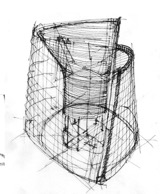
Source: radiopaedia.org
A pivot is the most important part of something, the central point on which a mechanism turns. From there, the word is used for many things or people. A person can be ‘the pivot’ of community life, its heart, its cornerstone or raison d’être. Within the architecture of language pronouns play a pivotal role, are of crucial importance. Here we shouldn’t lose sight of the physical, almost mechanical meanings of ‘pivot’ as movement in space. In basketball the player rotates but keeps the pivot foot in contact with the floor. Being pivotal stands for both stability and movement, and this is what characterises pronouns too.

Source: https://pin.it/2ZsTMVHVP
Let’s first address their stability, their role as possible cornerstones within a language’s architecture. It was the linguist Jakobson who pointed out that language could be understood as a physical body underpinned by a geometric, abstract structure. Its physical body is made up of nouns, verbs and adjectives, the bulk of words in our sentences. But there is something more abstract that determines its shape. The physique of language includes words that resemble a ‘geometric body’, an abstract shape that can be discerned. This shape is drawn by means of pivotal pronouns.

Source: Shutterstock
There is a level of abstraction in the physical world. The earth is not a perfect sphere, but the abstractive power of human thought allows us to see it as a sphere and represent it in this way. We superimpose simple geometrical relations upon the particular objects we see. We see circles, squares and rectangles in shapes that are far from regular, but this is the power of geometry, and the abstraction that underlies it. Jakobson observed that the relation of pronouns to the other words that surround them is like the relation between physical and geometric bodies. Pronouns taken together resemble a geometric body.

Dostoevsky (1872).
You, they, she, he are spoken in concrete situations, and each time they stand for a particular person. The word you or they doesn’t change, yet they shift from one person to another each time they are spoken. We call them ‘shifters’ or ‘slots for reality’. As if a world of persons pivots around these fixed expressions in language. Pronouns thereby uniquely determine the position of the speaker vis a vis other persons. Simply by saying, you, we, or they, this position becomes fixed for a moment within the flow of speech. Pronouns take on an abstract role as ‘coordinates’ for the person who speaks. Jakobson concluded that pronouns ‘mimic the abstract role of spatial coordinates’ in a physical world.

Source: Shutterstock
A virtual web is created centred on this geometric body within language. Speech is moored into its context, anchored through a series of virtual threads, that for example connect each you with a person that happens to be addressed in this instance. Language is held into place by the concrete stuffing of those pronominal spaces – of you, us, they. Once pronouns are taken out of their immediate context and are seen as a simple repetition of you or us their abstract role as potential ‘coordinates’ becomes clear. Within the continuous flow of language they continue to let us pivot towards different people, but as a kind of geometry they give stability to the architecture of language.

Source: https://en.m.wikipedia.org/wiki/File:Web.jpg
References
Dostoevsky, F. 1872 [2013]. The possessed. Golgotha Press.
p.1
Jakobson, R. (1968). The poetry of grammar, and grammar of poetry. Lingua, 21, 596-609.
pp. 605-606
Jakobson, R. (1981b). Grammatika i geometrija (Грамматика и геометрия, grammar and geometry). In S. Rudy (Ed.), Roman Jakobson selected writings III: Poetry of grammar and grammar of poetry (pp. 75–78). Mouton.
pp. 76–77